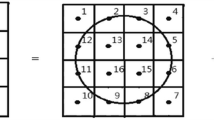Abstract
Rotation and scaling are two problems that must be solved in remote sensing detection. Most current methods only focus on the rotation invariance. In this paper, a novel target detection method based on pose-consistency voting is proposed to solve both the rotation and scaling problems, and improve detection precision in complicated optical remote sensing images. The proposed method defines a target pose to describe the direction and the scale of the detected target related to the target template. To detect the target in a detection window, the estimation-voting strategy is used. In the estimation stage, a large set of possible poses for the target in the detection window are predicted by pairs of pose-related pixels. Each pair of pose-related pixels is obtained through a pixel matching method based on the radial- gradient angle (RGA). As to the voting stage, based on the pose consistency property, all possible target poses vote in the angle-scale space to generate a pose histogram. The maximum value of the pose histogram is defined as the detection score of current detection window, and the pose corresponding to this max value is considered as the pose the detected target. Experimental results demonstrate that the proposed method is rotation-scale invariant, and is robust to the interference of shadow and occlusion. The detection performance in the complicated background is better than other state-of-the-art detection methods.

















Similar content being viewed by others
References
Barinova O, Lempitsky V, Kohli P (2012) On detection of multiple object instances using hough transforms. IEEE Trans Pattern Anal Mach Intell 34(9):1773–1784
Cheng G, Han J, Guo L, Qian X, Zhou P, Yao X, Hu X (2013) Object detection in remote sensing imagery using a discriminatively trained mixture model. ISPRS J Photogramm Remote Sens 85:32–43
Dalal N, Triggs B (2005) Histograms of oriented gradients for human detection. In: Proc. IEEE CVPR, vol 1, pp 886–893
Felzenszwalb PF, Girshick RB, McAllester D, Ramanan D (2010) Object detection with discriminatively trained part-based models. IEEE Trans Pattern Anal Mach Intell 32(9):1627–1645
Gu B, Sheng VS, Tay KY, Romano W, Li S (2015) Incremental support vector learning for ordinal regression. IEEE Trans Neural Netw Learn Syst 26 (7):1403–1416
Gu B, Sheng VS, Wang Z, Ho D, Osman S, Li S (2015) Incremental learning for ν-support vector regression. Neural Netw 67:140–150
Gu B, Sun X, Sheng VS (2016) Structural minimax probability machine. IEEE Transactions on Neural Networks and Learning Systems. doi:10.1109/TNNLS.2016.2544779
Harris C, Stephens M (1988) A combined corner and edge detector. In: Proc. Alvey vision conf., vol 15, pp 147–152
Hu MK (1962) Visual pattern recognition by moment invariants. IRE Trans Inf Theory 8(2):179–187
Kim WY, Kim YS (2000) A region-based shape descriptor using zernike moments. Signal Process.: Image Commun 16(1):95–102
Lei Z, Fang T, Huo H, Li D (2012) Rotation-invariant object detection of remotely sensed images based on texton forest and hough voting. IEEE Trans Geosci Remote Sens 50(4):1206–1217
Lin Y, He H, Chen F (2015) Rotation-invariant object detection in remote sensing images based on radial-gradient angle. IEEE Geosci Remote Sens Lett 12 (4):746–750
Liu L, Shi Z (2014) Airplane detection based on rotation invariant and sparse coding in remote sensing images. Optik 125(18):5327–5333
Lowe DG (1999) Object recognition from local scale-invariant features. In: Proc. IEEE ICCV, vol 2, pp 1150–1157
Neubeck A, Gool LV (2006) Efficient non-maximum suppression. In: Proc. Int. Conf. Pattern Recognition, pp 850–855
Nixon M, Aguado A (2008) 5 Feature extraction and image processing. Academic Press, Oxford, pp 228–235
Papakostas GA, Koulouriotis DE, Karakasis EG, Tourassis VD (2013) Moment-based local binary patterns: a novel descriptor for invariant pattern recognition applications. Neurocomputing 99:359–371
Sezgin M, Sankur B (2004) Survey over image thresholding techniques and quantitative performance evaluation. IEEE Trans Neural Netw Learn Syst 13(1):146–165
Sun H, Sun X, Wang H, Li Y, Li X (2012) Target detection in high-resolution remote sensing images using spatial sparse coding bag-of-words model. IEEE Geosci Remote Sens Lett 9(1):109–113
Wang L, Shi J, Song G, fan Shen I (2007) Object detection combining recognition and segmentation. In: Proc. ACCV, pp 189–199
Wen X, Shao L, Xue Y, Fang W (2015) A rapid learning algorithm for vehicle classification. Inf Sci 295(1):395–406
Xu J, Fu K, Sun X (2011) An invariant generalized hough transform based method of inshore ships detection. In: Proc. IEEE int. Symp. Image and data fusion, pp 1–4
Yang B, Li G, Zhang H, Dai M (2011) Rotation and translation invariants of gasussian-hermite moments. Pattern Recognit Lett 32(9):1283–1298
Yap PT, Paramesran R (2003) Image analysis by krawtchouk moments. IEEE Trans Image Process 12(11):1367–1377
Zhang W, Sun X, Fu K, Wang C (2014) Object detection in high-resolution remote sensing images using rotation invariant parts based model. IEEE Geosci Remote Sens Lett 11(1):74–78
Zheng Y, Jeon B, Xu D, Wu QJ, Zhang H (2015) Image segmentation by generalized hierarchical fuzzy c-means algorithm. J Intell Fuzzy Syst 28(2):961–973
Acknowledgments
The research has been supported by the National Natural Science Foundation of China, People’s Republic of China (61373180, 61461047), and the Technical Innovation Talent Project of Sichuan Province (2015042).
Author information
Authors and Affiliations
Corresponding author
Rights and permissions
About this article
Cite this article
Lin, Y., He, H., Tai, HM. et al. Rotation and scale invariant target detection in optical remote sensing images based on pose-consistency voting. Multimed Tools Appl 76, 14461–14483 (2017). https://doi.org/10.1007/s11042-016-3857-5
Received:
Revised:
Accepted:
Published:
Issue Date:
DOI: https://doi.org/10.1007/s11042-016-3857-5




